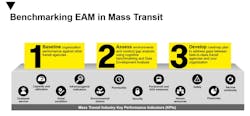Best Practices - Asset Management: Leveraging Benchmarking to Develop a Digital EAM Strategy in Mass Transit
In today’s world, mass transit organizations are facing more pressure than ever to reduce capital expenses, offset revenue losses with operational cost reductions and improved efficiencies and meet health, safety and security commitments while still providing a positive customer experience.
Effective EAM Begins with a Clear Business Vision
Deploying an effective EAM system begins with clarifying the business vision to consider internal and external business drivers, as well as insights from tools such as cognitive benchmarking. Aided by advanced AI-related methodologies, transit companies can determine a performance baseline in key areas--including financial, technical and operational–against the comparable proficiency of other transit authorities. Next, gap analyses leveraging machine learning algorithms determine where an organization differs from both best-in-class agencies and the industry’s median while taking into consideration the agency’s unique risks.
Establish a Roadmap to Address Critical Areas of Improvement
We often refer to benchmarking as a three-step process: baseline, assess and develop. This process allows management to narrow down more than 100 possible key performance indicators (KPIs) to just three or four that will likely be most impactful to achieving the business vision. These factors could include asset condition, capacity and utilization, customer service, environmental impacts, service continuity, etc. The organization then needs to set realistic and measurable goals for improvement.
Management can track progress over time using a reporting dashboard. This dashboard allows a transit agency’s board members to observe the progress made and encourages them to stay engaged. This type of dashboard can also be adapted to run on smartphones and tablets for mobile use.
Benchmarking must be Enabled by Robust Information and Data Architectures
Data is key to any digital transformation effort, so the next step is setting up a network to harvest information from Internet of Things edge devices, which can run the gamut from onboard diagnostics to mobile devices, wearables and video cameras. Transit agencies need to create integrated, multidimensional information and data-centric views of their assets to ensure that the right details are captured in the right format to support the benchmarking effort and subsequent decision making. Deployed in a measured, strategic manner, benchmarking activities can produce significant benefits to mass transit agencies in their digital EAM journey. Once digital EAM is up and running, organizations will extract additional value from existing assets through continuous improvement, grounded in leveraged actionable insights from real-time data.
----------------------------------
Frank (Chip) Knowlton is Partner, Travel, Transportation and Hospitality with DXC Technology.
About the Author

Frank (Chip) Knowlton
Partner, Travel, Transportation and Hospitality, DXC Technology
Chip is Partner, Travel, Transportation and Hospitality with DXC Technology. He was previously Executive Program Manager for New York City Transit’s (NYCT) EAM program and Center of Excellence. A certified EAM professional, he has an extensive background in working with asset-intensive public and private organizations to improve their EAM practices to achieve business and organizational objectives.

